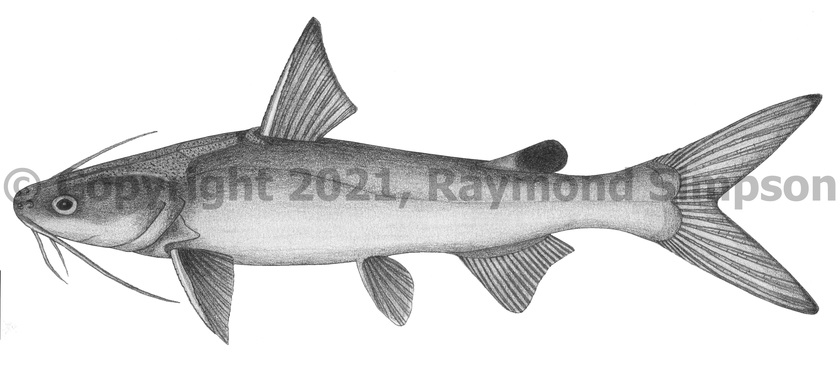
Common Name
Hardhead Sea Catfish
Year Described
Linnaeus, 1766
Identification
Dorsal Fin: I, 7
Pelvic Fin: 6
Anal Fin: 17-19
Pectoral Fin: 9-11
Caudal Fin: 13 branched (6 upper, 7 lower)
Gill Rakers: 13-16 on first arch, 13-17 on second arch
The following characters taken together are characteristic of Ariopsis according to Marceniuk et al., 2017: posterior cranial fontanel absent, epiphyseal scar indistinct, temporal fossa absent or indistinct, subvertebral process weak, posterolateral uruhyal process subequal to distal end of bone, obvious fenestra surrounded by lateral ethmoid and frontal bone, gill rakers present on posterior margin of first two gill arches, and females possessing pads on the pelvic fins.
Body elongate and robust. Head long and relatively flattened, with a gradual frontal profile becoming steeper beyond the supraoccipital processes. Head plate obvious and bumpy. Cephalic shield long; rectangular or slightly narrower between eyes. Lateral processes on shield triangular and projecting laterally. Dorsomedial depression present. Fleshy portion of deep dorsomedial groove long and obvious, extending well forward to between eyes. Bony posterior ridge present but weak Rear of process tapering to a crescent shaped and bumpy nuchal plate. Lateral margin of sphenotic notched. Pterotic margin weakly convex. Snout rounded. Nostrils not connected by a furrow. Anterior nostril round with fleshy rim and posterior with a flap covering opening. Eye large and laterally placed. Three pairs of barbels; maxillary much longer than both mental barbels. Mouth subterminal with thick lips and arched jaw. A single arched patch of villiform teeth on maxillary. Palatine teeth with two rounded or oval patches (usually touching) on each side of palate (one small and one large). Gill rakers present on all arches. Dorsal fin high with a strong, weakly serrated spine. Pectoral fins about the same size as dorsal fin with strong, weakly serrated spines. Pelvic and anal fins located far back on body. Adipose fin present over anal fin base. Caudal fin strongly forked. Body naked. Free vertebrae 46-48.
Color
Brown, olive, gray or dark blue above. Sides and belly grade abruptly to whitish with a blue sheen in life. Fins uniformly gray with a blue sheen on the dorsal and caudal fins. Adipose fin with a large black blotch. Caudal fin with a thin black margin.
Size
Maximum size to 70cm TL but usually less than 30cm TL.
Habitat
Primarily an estuarine species in shallow brackish and saltwater over soft bottoms. Occasionally enters pure freshwater.
Range
North Carolina to the northwestern Yucatan Peninsula, including the Gulf of Mexico.
References
Marceniuk, A.P., Acero, A.P., Cooke, R.G., & Betancur-R, R. 2017. Taxonomic revision of the New World genus Ariopsis Gill (Siluriformes: Ariidae), with description of two new species. Zootaxa.
Other Notes
The strong fleshy keel along the median depression that extends forwards to between the eyes distinguishes this species from the two other W. Atlantic Ariopsis. This is the only species of marine catfish found in U.S. waters besides Bagre marinus and is easily distinguished by barbel number (3 vs. 2 pairs).